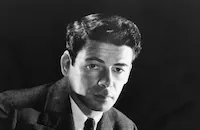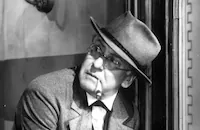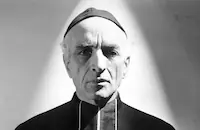Angel on My Shoulder

Brief Synopsis
Cast & Crew
Archie Mayo
Paul Muni
Anne Baxter
Claude Rains
Onslow Stevens
George Cleveland
Film Details
Technical Specs

Synopsis
Soon after his release from prison, gangster Eddie Kagle is killed by his longtime friend and associate, Smiley Williams, and wakes in Hell. When Eddie realizes what has happened, he immediately attempts to break out of Hell and avenge his death. His actions draw the attentions of Nick, the Devil, who notices Eddie's close resemblance to Frederick Parker, an incorruptible judge who is running for governor. Nick offers to help Eddie escape and get even with Smiley, if he, in turn, will help Nick destroy Parker's reputation. Eddie readily agrees and, accompanied by Nick, returns to earth. Nick causes Parker to faint, and while he is unconscious, transfers Eddie's soul into Parker's body. Eddie's first impulse is to murder Smiley. With this in mind, he uses some of Parker's money to buy a gun and charter an airplane. Nick has other plans for Eddie, however, and the plane suddenly develops engine trouble and returns to the field. Barbara Foster, Parker's fiancée, is unaware that Eddie's soul now inhabits Parker's body, and consequently, Eddie's crude behavior convinces her that Parker is mentally ill. Nonetheless, she prompts Eddie to deliver Parker's scheduled political speech. At the auditorium, Eddie, encouraged by Nick, verbally attacks the people who have been Parker's supporters. When opposition hecklers pelt Eddie with rotten vegetables, however, he angrily beats them up, making Parker appear to be a virile hero, rather than the turncoat that Nick had envisioned. The next day Parker is to preside over a murder trial. Eddie offers to fix the result for money, but when he learns that one of the suspects is Rosie, his former girl friend, who married another man while he was in jail, he vows to do everything possible to ensure her conviction. Dr. Max Higgins then persuades Barbara to take Eddie away for a brief rest, hoping it will restore the judge to health. Barbara drives Eddie to the site where Parker and she are building a house. As they talk, Eddie, who has fallen in love with Barbara, realizes what he missed when he became a criminal. Barbara presses for an immediate marriage and Eddie agrees, but after he hears the minister's sermon, he realizes that she belongs to the judge and calls off the wedding. Meanwhile, acting on a suggestion from Nick, Parker's opponents bring Smiley to town and send him to Parker's house. Nick reports Smiley's presence to Eddie, who, because of Barbara's influence, understands that he will be doing wrong if he kills Smiley. Rather than listen to Nick, Eddie heeds the "angel on his shoulder" and refuses to take revenge on his enemy. A confused Smiley then accidentally falls off Parker's balcony to his death. Eddie now agrees to accompany Nick back to Hell, if Nick agrees to leave Barbara and Parker alone for eternity. Nick has no choice but to accept Eddie's terms. After Eddie says goodbye to a mystified Barbara, Nick returns Parker's soul to his body and he and Eddie descend into Hell.

Director

Archie Mayo
Cast

Paul Muni

Anne Baxter

Claude Rains

Onslow Stevens
George Cleveland

Erskine Sanford

Marion Martin

Hardie Albright

James Flavin

Jonathan Hale
Murray Alper
Joan Blair

Fritz Leiber
Kurt Katch
Sarah Padden

Addison Richards
Ben Welden

George Meeker
Lee Shumway
Russ Whiteman
James Dundee
Mike Lally
Saul Gorss
Duke Taylor

Edward Keane
Chester Clute
Crew
Howard Anderson
George Arthur
Leon Becker
Edward G. Boyle
Wilbur Bradley
Mario Castegnaro
Asa Clark
Maria Donovan
Clarence Eurist
William J. Fender
Bernard Herzbrun
Joseph I. Kane
Roland Kibbee
Robert Martien
Harry Redmond Jr.
Charles R. Rogers
Charles R. Rogers
Harry Segall
Harry Segall
David W. Siegel
Jack Sullivan
David Sussman
Dimitri Tiomkin
James Van Trees
Frank Webster
Ern Westmore

Videos
Movie Clip



Hosted Intro
Film Details
Technical Specs

Articles
Angel On My Shoulder (1946) - Angel on My Shoulder (1946)
Muni had catapulted to stardom playing a gangster in Scarface (1932) but was known to never want to play such a character again. He turned down the offer to play one here, telling his agent, "Fantasy hardly ever works." Rogers, however, wouldn't give up. He hired screenwriter Roland Kibbee to collaborate with Segall on a new draft, with the slightly different title Me and Mr. Satan. Though the script now had more depth and nuance, again Muni said no. After another rewrite and another new title, Angel on My Shoulder, Muni agreed to do the picture. By most accounts, the actor came to the conclusion that he needed to boost his lagging film career with what seemed like a commercial hit. His wife, Bella, seemed to think so, and she wielded great influence. It's also likely that Muni was keen on the opportunity to slightly caricature his gangster character, as the new script called for him to do. It may still have been a gangster, but it was written with a much lighter touch than the deadly serious Scarface.
For a picture that ultimately was not a commercial hit - it came and went quickly in theatres in 1946 - Angel on My Shoulder had plenty of behind-the-scenes drama. Muni, Rains, co-star Anne Baxter and director Archie Mayo all came down with the flu, delaying production for a total of four weeks. Assistant director Jack Sullivan died suddenly during production and had to be replaced. And at the film's wrap party, hosted by Muni, a studio electrician died after falling off a catwalk. It turned out the man hadn't even worked on the film, but the resulting publicity and investigation proved too much for Muni. As biographer Jerome Lawrence later wrote, "Muni, who rarely attended parties and practically never played host, swore he would never go near a party again - his own or anybody else's."
The main source of drama was on the set, between Muni and Archie Mayo, who was definitely not an "actor's director." Though the two men had previously collaborated on Bordertown (1935), that did not quell their conflicts on Angel. Anne Baxter later recounted: "I think [Muni] was trying to recapture Scarface. His career was in a downward slide and he wanted the film to be more than it was. Archie Mayo was not a director in depth, which of course was an approach completely in contrast to Muni, who had to know the meaning behind every syllable. The two were in constant conflict, which made for a very unhappy set...Mayo was primarily a canner. Do the take, do the cover shot, reverse angle, close-up, get it in the can. It was like a Big Boy hamburger directing a fine gourmet Wiener schnitzel."
Baxter was drawn to this project solely because it meant a chance to work with Muni, and she plays very well opposite him. On a personal level, though, Baxter found Muni to be "a very lonely man. A boy-child really. And Bella was Mama. I found Muni fascinating [and] attractive...but he was essentially 'sous-cloche' - a spirit enclosed under glass."
Angel on My Shoulder received mixed reviews and was compared unfavorably to Here Comes Mr. Jordan. Variety was effusive, praising the film's "zip" and extolling the performances of Muni, Rains and Baxter, but The New York Times' Bosley Crowther was more typical, calling the film "repetitious" and "full of hokum... The story is so imitative - and is repeated so dutifully - that it's hard to feel any more towards it than a mildly nostalgic regard." Crowther added, "Mr. Rains gives a drab and depressing imitation of his memorable Mr. Jordan role."
Muni was so despondent over Angel's weak box-office that he left the movie business for quite some time. It would be another six years until he made another picture, the unsuccessful Italian production Stranger on the Prowl (1952), directed by Joseph Losey, and another seven years after that until he made another American film, The Last Angry Man (1959) - his final film, for which he received his sixth and final Oscar® nomination. In between these productions, he concentrated primarily on theater work.
Angel on My Shoulder is notable for its striking depiction of hell, an unusual sight in the movies. A February 1946 New York Times article said that producer Charles Rogers had his PR department put out a call for help in ideas for designing hell. This resulted in art director Bernard Herzbrun receiving a mountain of letters, "some with sketches, informing him how Hades should be presented in the picture."
The article continued: "It is not unusual for such publicity blurbs to bring hundreds of letters from movie fans of the 'I was there' type, but in this case the suggestions set some kind of a precedent. Mr. Herzbrun finally settled for an adaptation of Dore's illustrations from Dante's 'Inferno' and Milton's 'Paradise Lost,' plus a suggestion of the Carlsbad Caverns of New Mexico, with all the victims of the film's fiery torture chamber to be draped, of course, to conform to the tenets of the industry's purity code."
Producer: Charles R. Rogers
Director: Archie Mayo
Screenplay: Harry Segall, Roland Kibbee; Harry Segall (story)
Cinematography: James Van Trees
Art Direction: Bernard Herzbrun
Music: Dimitri Tiomkin
Film Editing: Asa Clark
Cast: Paul Muni (Eddie Kagle/Judge Frederick Parker), Anne Baxter (Barbara Foster), Claude Rains (Nick), Onslow Stevens (Dr. Matt Higgins), George Cleveland (Albert), Erskine Sanford (Minister), Marion Martin (Mrs. Bentley), Hardie Albright (Smiley Williams), James Flavin (Bellamy), James Dundee (Gangster).
BW-101m. Closed Captioning.
by Jeremy Arnold
Sources:
Michael Druxman, Paul Muni: His Life and Films
Jerome Lawrence, Actor: The Life and Times of Paul Muni
James Robert Parish, Tough Guys

Angel On My Shoulder (1946) - Angel on My Shoulder (1946)
Angel on My Shoulder (1946)
Paul Muni was an unlikely choice for the lead because of his association with such serious dramatic roles as Scarface and I am a Fugitive From a Chain Gang but clearly, as this film demonstrates, he could have had a career as a world-class farceur. As proof, we submit the scenes involving Eddie's transition from a vulgar thug to a refined and respected pillar of the community.
Offscreen, the laughs were few and far between. Archie Mayo, the director, and Muni didn't always see eye to eye on how the story should be played, arguing constantly and creating enormous tension on the set. Another unfortunate situation developed when a grip fell to his death from a scaffold toward the end of production. Now that we've painted such a bright and sunny picture of what was happening behind-the-scenes on Angel on My Shoulder, would you believe that this is really a delightful and underrated comedy?
Director: Archie Mayo
Producer: Charles R. Rogers
Screenplay: Harry Segall, Roland Kibbee
Cinematography: James Van Trees
Music: Dimitri Tiomkin
Cast: Paul Muni (Eddie Kagle/Judge Parker), Claude Rains (Nick/The Devil), Anne Baxter (Barbara Foster), Erskine Sanford (Minister), Onslow Stevens (Dr. Matt Higgins).
BW-102m.
by Jeff Stafford
Angel on My Shoulder (1946)
Quotes
Trivia
Notes
The film's working title was Me and Satan. The film begins with the following written foreword: "This story is about Eddie Kagle, who based his way of living on what Omar Khayyam once said: 'Live fully while you May and reckon not the cost.'" A August 15, 1944 Hollywood Reporter news item notes that the filmmakers wanted Ann Dvorak to star in the film. A June 16, 1946 New York Times news item notes that actors Paul Muni and Claude Rains and director Archie Mayo all suffered from the flu during production, which prolonged shooting time from the scheduled nine weeks to thirteen weeks. Clarence Eurist replaced Jack Sullivan as assistant director when the latter died unexpectedly. The face of the character of "Frederick Parker" is only seen when inhabited by "Eddie's" soul. Harry Segall, who receives original story credit on this film, also wrote the original story for the 1941 Columbia film Here Comes Mr. Jordan, which had a very similar plot (see below). Angel on My Shoulder was remade for television in 1980. That film was directed by John Berry and starred Peter Strauss.















